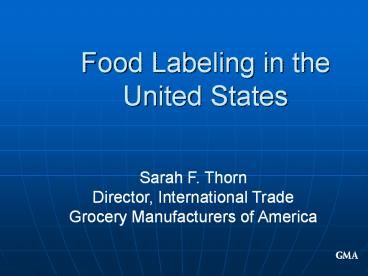Food Labeling in the United States - PowerPoint PPT Presentation
Title:
Food Labeling in the United States
Description:
Health (nutrition) Safety (allergens) Quality (brands) Sacred space ... FDA proposed change to nutrition facts label. Addition of trans fat information ... – PowerPoint PPT presentation
Number of Views:135
Avg rating:3.0/5.0
Title: Food Labeling in the United States
1
Food Labeling in the United States
Sarah F. Thorn Director, International
Trade Grocery Manufacturers of America
2
GMA Member Companies
3
Introduction
?
- Consumers receive information from a variety of
sources - Manufacturers are committed to providing truthful
non-misleading information about their products - Label is not always best means to communicate
with consumers
4
Labels and Food Products Manufacturers View
- Mandatory requirements
- Should be used to convey essential information
related to product attributes such as - Health (nutrition)
- Safety (allergens)
- Quality (brands)
- Sacred space
- Mandatory requirements must be reserved for
legitimate goals
5
Example Food Labeling of Trans Fats
- November 1999 Proposed rule for trans fat
labeling - September 2002 Dietary Reference Intake report
on macronutrientsNAS/IOM - Link between trans fats and heart disease
- Recommendation to keep consumption as low as
possible with caveats - November 2002 Reopening of the comment period
6
Example Trans Fats
- FDA proposed change to nutrition facts label
- Addition of trans fat information
- Asterisk added under Daily Value for trans fats
- Footnote saying intake of trans fats should be
as low as possible
Question How will consumers respond to the
proposed footnote?
7
Consumer StudyButter vs. Margarine Label Set 1
Spread A
Spread B
14
86
8
Consumer StudyButter vs. Margarine Label Set 2
Spread A
Spread B
53
47
9
Consumer StudyButter vs. Margarine Label Set 3
Spread A
Spread B
70
30
10
Consumer Choices Due to Label Information
Butter 7g sat fat 0 g trans fat
Selecting Product as Healthier Choice
Margarine 2g sat fat 2 g trans fat
11
Trans Fat Result
- FDA issued final rule requiring a quantitative
declaration of trans fats in the information
facts panel - New ANPR for more broad footnote on all fats
- Industry continues to believe that the label is
not the appropriate venue for dietary guidance
12
Example Labeling of Biotech Products
13
Biotech Labeling Market Environment
Consumer Concern
Activists Campaigns
Demand for label to avoid biotech foods
National Media Frankenfoods
14
Biotech Labeling Consumer Impact
- Consumer right to know
- Mandatory process based labeling
- Perceived as a warning label
- Inappropriate forum for risk communication
- Restricts trade by discriminating against like
products
15
Biotech Labeling Manufacturing Impact
- Changes in production
- Shift lines abroad for local production
- Changes in product composition
- Reformulate products at significant cost
- EC Ag Directorate Report
- - 6-17 Consumer Price Increase
- - 6-50 Agri-foodchain Cost Increase
- GMA/KPMG Study
- - 5-10 Consumer Price Increase
- - 32-63 Agri-foodchain Cost Increase
16
Biotech Labeling Trade Impact
- Discriminates against like products
- Significant impact on food and agriculture
exports - Alternative, less restrictive approaches
available to meet goal
US Snack Food Exports to the EU
17
Codex and Biotech
- Codex Committee on Food Labeling
- Work on guidelines for international
harmonization of biotech labeling since 1993 - Deep divisions in group based on preference to
replicate national laws - Friends of the Chair Group to discuss how to
proceed
18
Example Organic Labeling
- Strong consumer demand but divergent standards
- 2002 Final Rule
- Production, labeling and certification standards
- Labeling standards based on percent of organic
ingredients - 100 Percent Organic
- Made with Organic Ingredients
19
Organic Standards Consumer Response
- Voluntary Standards
- Market based approach
- Consumers who want particular qualities pay for
those attributes - Allows for niche markets to develop
- Allows for future harmonization of voluntary
standards and less trade disruption
20
Voluntary Organic Standards Market Impact
- Significant US growth
- U.S. sales in 2001 9.5 Billion
- 10-20 growth rate
- Available in 73 of conventional grocery stores
- Major world markets growth
- 1997 2001
- 11 Billion 21 Billion
- Substantial price premiums
21
Conclusion
- Need to recognize that mandatory labeling
requirements can lead to technical barriers to
trade - Every mandatory label has a cost to consumers and
manufacturers. We need to balance benefits and
costs and choose most appropriate policy to meet
objectives. - Need to emphasize good regulatory practices
towards labeling policy































